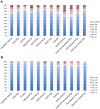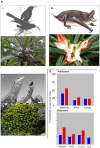Mutualism Disruption Threatens Global Plant Biodiversity: A Systematic Review
- PMID: 23840571
- PMCID: PMC3686776
- DOI: 10.1371/journal.pone.0066993
Mutualism Disruption Threatens Global Plant Biodiversity: A Systematic Review
Abstract
Background: As global environmental change accelerates, biodiversity losses can disrupt interspecific interactions. Extinctions of mutualist partners can create "widow" species, which may face reduced ecological fitness. Hypothetically, such mutualism disruptions could have cascading effects on biodiversity by causing additional species coextinctions. However, the scope of this problem - the magnitude of biodiversity that may lose mutualist partners and the consequences of these losses - remains unknown.
Methodology/principal findings: We conducted a systematic review and synthesis of data from a broad range of sources to estimate the threat posed by vertebrate extinctions to the global biodiversity of vertebrate-dispersed and -pollinated plants. Though enormous research gaps persist, our analysis identified Africa, Asia, the Caribbean, and global oceanic islands as geographic regions at particular risk of disruption of these mutualisms; within these regions, percentages of plant species likely affected range from 2.1-4.5%. Widowed plants are likely to experience reproductive declines of 40-58%, potentially threatening their persistence in the context of other global change stresses.
Conclusions: Our systematic approach demonstrates that thousands of species may be impacted by disruption in one class of mutualisms, but extinctions will likely disrupt other mutualisms, as well. Although uncertainty is high, there is evidence that mutualism disruption directly threatens significant biodiversity in some geographic regions. Conservation measures with explicit focus on mutualistic functions could be necessary to bolster populations of widowed species and maintain ecosystem functions.
Conflict of interest statement
Figures




Similar articles
-
Sexual Harassment and Prevention Training.2024 Mar 29. In: StatPearls [Internet]. Treasure Island (FL): StatPearls Publishing; 2025 Jan–. 2024 Mar 29. In: StatPearls [Internet]. Treasure Island (FL): StatPearls Publishing; 2025 Jan–. PMID: 36508513 Free Books & Documents.
-
A scoping review of tropical pioneer trees' roles for restoration and conservation management: Harungana madagascariensis (Hypericaceae) a widespread African species as a model.PeerJ. 2025 May 23;13:e19458. doi: 10.7717/peerj.19458. eCollection 2025. PeerJ. 2025. PMID: 40421372 Free PMC article.
-
The Effects of Climate Change on Mesocarnivores: A Global Review and Meta-Analysis.Glob Chang Biol. 2025 Jun;31(6):e70302. doi: 10.1111/gcb.70302. Glob Chang Biol. 2025. PMID: 40515447 Review.
-
Factors that influence parents' and informal caregivers' views and practices regarding routine childhood vaccination: a qualitative evidence synthesis.Cochrane Database Syst Rev. 2021 Oct 27;10(10):CD013265. doi: 10.1002/14651858.CD013265.pub2. Cochrane Database Syst Rev. 2021. PMID: 34706066 Free PMC article.
-
Measures implemented in the school setting to contain the COVID-19 pandemic.Cochrane Database Syst Rev. 2022 Jan 17;1(1):CD015029. doi: 10.1002/14651858.CD015029. Cochrane Database Syst Rev. 2022. Update in: Cochrane Database Syst Rev. 2024 May 2;5:CD015029. doi: 10.1002/14651858.CD015029.pub2. PMID: 35037252 Free PMC article. Updated.
Cited by
-
A novel bat pollination system involving obligate flower corolla removal has implications for global Dillenia conservation.PLoS One. 2022 Feb 3;17(2):e0262985. doi: 10.1371/journal.pone.0262985. eCollection 2022. PLoS One. 2022. PMID: 35113889 Free PMC article.
-
Mutualistic strategies minimize coextinction in plant-disperser networks.Proc Biol Sci. 2017 May 17;284(1854):20162302. doi: 10.1098/rspb.2016.2302. Proc Biol Sci. 2017. PMID: 28490622 Free PMC article.
-
Mutualism breakdown underpins evolutionary rescue in an obligate cross-feeding bacterial consortium.Nat Commun. 2025 Apr 12;16(1):3482. doi: 10.1038/s41467-025-58742-1. Nat Commun. 2025. PMID: 40216843 Free PMC article.
-
Accelerating homogenization of the global plant-frugivore meta-network.Nature. 2020 Sep;585(7823):74-78. doi: 10.1038/s41586-020-2640-y. Epub 2020 Sep 2. Nature. 2020. PMID: 32879498
-
Bee and butterfly records indicate diversity losses in western and southern North America, but extensive knowledge gaps remain.PLoS One. 2024 May 15;19(5):e0289742. doi: 10.1371/journal.pone.0289742. eCollection 2024. PLoS One. 2024. PMID: 38748698 Free PMC article.
References
-
- Barnosky AD, Matzky N, Tomiya S, Wogan GOU, Swartz B, et al. (2011) Has the Earth's sixth mass extinction already arrived? Nature 471: 51–57. - PubMed
-
- Tylianakis JM, Didham RK, Bascompte J, Wardle DA (2008) Global change and species interactions in terrestrial ecosystems. Ecol Lett 11: 1351–1363. - PubMed
-
- Estes JA, Terborgh J, Brashares JS, Power ME, Berger J, et al. (2011) Trophic downgrading of Planet Earth. Science 333: 301–306. - PubMed
-
- Bronstein JL, Dieckmann U, Ferrière R (2004) Coevolutionary dynamics and the conservation of mutualisms. In: Ferrière R, Dieckmann U, Couvet D, editors. Evolutionary conservation biology. Cambridge: Cambridge University Press. 305–326.
Publication types
MeSH terms
LinkOut - more resources
Full Text Sources
Other Literature Sources
Research Materials

